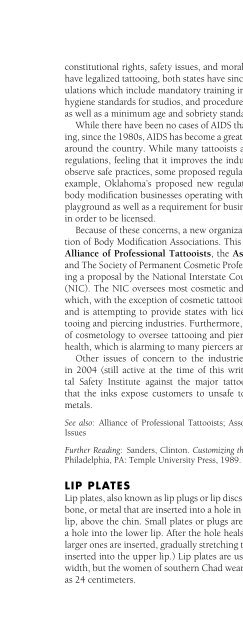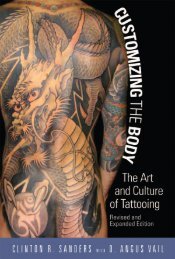Encylopedia of Body Adornment.pdf - Print My Tattoo
Encylopedia of Body Adornment.pdf - Print My Tattoo
Encylopedia of Body Adornment.pdf - Print My Tattoo
Create successful ePaper yourself
Turn your PDF publications into a flip-book with our unique Google optimized e-Paper software.
LIP PLATES 179<br />
constitutional rights, safety issues, and morality. As is common when legislatures<br />
have legalized tattooing, both states have since adopted new health and safety regulations<br />
which include mandatory training in blood-borne pathogens, health and<br />
hygiene standards for studios, and procedures such as single-use needles and ink,<br />
as well as a minimum age and sobriety standards.<br />
While there have been no cases <strong>of</strong> AIDS that can be traced to tattooing or piercing,<br />
since the 1980s, AIDS has become a great concern, leading to more regulations<br />
around the country. While many tattooists and piercers welcome many <strong>of</strong> these<br />
regulations, feeling that it improves the industry when all tattooists and piercers<br />
observe safe practices, some proposed regulations are seen as overly invasive. For<br />
example, Oklahoma’s proposed new regulations may include a prohibition on<br />
body modification businesses operating within 1,000 feet <strong>of</strong> a church, school, or<br />
playground as well as a requirement for business owners to post a $100,000 bond<br />
in order to be licensed.<br />
Because <strong>of</strong> these concerns, a new organization has formed known as the Coalition<br />
<strong>of</strong> <strong>Body</strong> Modification Associations. This informal coalition is made up <strong>of</strong> the<br />
Alliance <strong>of</strong> Pr<strong>of</strong>essional <strong>Tattoo</strong>ists, theAssociation <strong>of</strong> Pr<strong>of</strong>essional Piercers,<br />
and The Society <strong>of</strong> Permanent Cosmetic Pr<strong>of</strong>essionals, and they are currently fighting<br />
a proposal by the National Interstate Council <strong>of</strong> State Boards <strong>of</strong> Cosmetology<br />
(NIC). The NIC oversees most cosmetic and beauty fields in this country (all <strong>of</strong><br />
which, with the exception <strong>of</strong> cosmetic tattooing, involve noninvasive procedures),<br />
and is attempting to provide states with licensing exams to be used by the tattooing<br />
and piercing industries. Furthermore, the NIC is lobbying to allow boards<br />
<strong>of</strong> cosmetology to oversee tattooing and piercing, rather than the state boards <strong>of</strong><br />
health, which is alarming to many piercers and tattooists.<br />
Other issues <strong>of</strong> concern to the industries include a California lawsuit filed<br />
in 2004 (still active at the time <strong>of</strong> this writing) by the American Environmental<br />
Safety Institute against the major tattoo ink manufacturers, which claims<br />
that the inks expose customers to unsafe toxins such as lead and other heavy<br />
metals.<br />
See also: Alliance <strong>of</strong> Pr<strong>of</strong>essional <strong>Tattoo</strong>ists; Association <strong>of</strong> Pr<strong>of</strong>essional Piercers; Health<br />
Issues<br />
Further Reading: Sanders, Clinton. Customizing the <strong>Body</strong>: The Art and Culture <strong>of</strong> <strong>Tattoo</strong>ing.<br />
Philadelphia, PA: Temple University Press, 1989.<br />
LIP PLATES<br />
Lip plates, also known as lip plugs or lip discs, are items made <strong>of</strong> clay, wood, stone,<br />
bone, or metal that are inserted into a hole in the lower lip, or the area beneath the<br />
lip, above the chin. Small plates or plugs are generally inserted after slicing open<br />
a hole into the lower lip. After the hole heals around the plate, it is removed and<br />
larger ones are inserted, gradually stretching the hole. (In some cases a plate is also<br />
inserted into the upper lip.) Lip plates are usually no larger than 3 centimeters in<br />
width, but the women <strong>of</strong> southern Chad wear extremely large plates, <strong>of</strong>ten as large<br />
as 24 centimeters.



